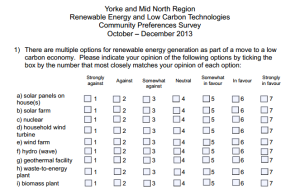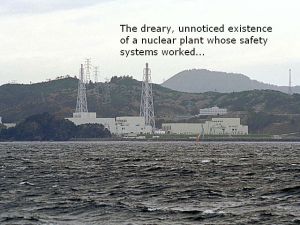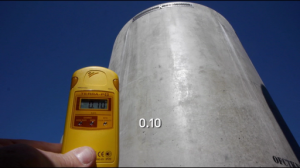Parnell: “By the time you’ve taken into account the carbon emissions in the energy used to mine and process the uranium, built the reactor, operated the reactor, decommission the reactor and then store and monitor the waste for hundreds of thousands of years, … you find that the whole of life carbon emissions really add up.” But to merely the smallest fraction of the equivalent from oil, gas and particularly coal, which is what is installed in countries that avoid nuclear. The Greens listen to the IPCC when it comes to AGW… But apparently not when it conflicts with their tired, myopic anti-nuclear polemic.

Used for illustrative purposes without permission. http://www.connyankee.com/
And Fukushima, which I and others have covered previously and comprehensively, and which I really was trying to move on from. Parnell is no less ignorant about the reality of Fukushima and the consequences of contaminated water release than my anonymous tweeter. Except that Parnell is an elected official, ostensibly representing the interests of Australia’s environment.
What do these sorts of commenters (and I’d hazard to guess the vast majority of people who identify as environmentalists) think is the true intention of nuclear professionals and scientifically informed interviewees, who state that releasing the cooling water into the Pacific is a good solution? I contend that there is indeed no thought involved. I am fully aware of how negative the idea seems prima facie, and thus I’m actually able to initially sympathise with those who reject it. But what should not be entertained is their righteous denial that the idea could be scientifically informed. That the idea, all else being equal, could be the right thing to do. It’s the same mentality that allows the dismissal of implorations from eminent climate scientists because they use the “N word”; it’s what we see here after a blinkered environmentalist apparently sits through Pandora’s Promise and utterly misses the point:
The uncomfortable truth is that the people presenting this unpopular option are not soulless monsters. They care at least just as much about the environment, children and civilisation as any given orthodox environmentalist.
C1V1 = C2V2
Let me be illustrative in response. Concentration and volume follow the above relationship for any given solute. When Volume 1 containing a Concentration 1 of a solute is mixed into a larger Volume 2, then Concentration 2 is necessarily less. You don’t need to be a chemist to understand this, but it underpins virtually all wet chemistry. As long as units are consistent and appropriate, it matters not what they are. Breathless news reports claim up to 300 tons of contaminated water leak into the Pacific each day.
The Pacific is 7.14 x 10^17 metric tonnes of water.*
* With a lot of rounding for density, etc. and assuming even diffusion throughout ocean, obviously.







